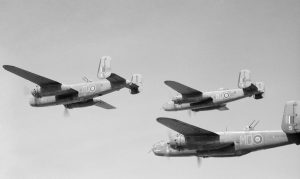Patrick’s eldest son, William, served on 142 Squadron in the first five months of 1942. In that period, the Squadron launched 256 sorties and lost 10 aircraft, a loss rate of 4%. This loss rate gives a crew a 50% chance of surviving beyond their 17th mission. From accounts that I have read, the majority of aircrew blanked out the odds and told themselves that ‘it wouldn’t happen to me’. Experience seems to have been important: the first few missions were statistically more dangerous than the later ones. That is, of course, if they lived long enough to accumulate experience. Reports are full of references to appalling weather and the difficulties of finding targets, even though these were often major sites. Valuable targets were well defended. William’s last completed mission, his sixth, to Cologne, lasted 4½ hours. About half of that time would have been spent over enemy territory. The danger did not disappear even close to home. Night fighters sometimes stalked returning aircraft as they landed. The crew would have been on high alert throughout their time in the air.
The situation in the middle of 1944 was quite different for Patrick’s son-in-law Les Dunn. Over 11,000 aircraft were available on D-Day. They flew over 14,000 missions. Air superiority had been achieved. The risk from enemy fighters was small, although ground fire remained a problem, as Les Dunn’s crew were to discover. 226 Squadron flew missions supporting the D-Day invasion. The targets, such as fuel depots, troop concentrations and railway marshalling yards, were all close to the Normandy coast. A typical mission lasted two hours, with only a few minutes of those being exposed to significant danger. The reports also mention special equipment to assist bomb aiming. This is a reference to GEE, a system that used radio to triangulate a position. It could be used up to 350 miles from the transmitting stations. It provided accuracy of a few hundred meters. The Normandy coast is only 150 miles from England, conferring greater accuracy.
 In June, 226 Squadron flew 261 sorties for the loss of one plane. In July, another 289 sorties were flown with, again, only a single plane lost. The squadron was despatching aircraft two or even three times a day as new targets were identified. The first half of August (another 181 sorties) saw no losses. The aircrew must have started to treat missions as routine: briefing, fly to France, attack, return to England and repeat. (Picture shows aircraft from 226 Squadron)
In June, 226 Squadron flew 261 sorties for the loss of one plane. In July, another 289 sorties were flown with, again, only a single plane lost. The squadron was despatching aircraft two or even three times a day as new targets were identified. The first half of August (another 181 sorties) saw no losses. The aircrew must have started to treat missions as routine: briefing, fly to France, attack, return to England and repeat. (Picture shows aircraft from 226 Squadron)
The first two losses in August took place on the 17th, from separate missions. Only one crew member (the pilot) died as the others were able to parachute to safety. The loss of an entire crew must have come as a shock to everyone on the Squadron. Les Dunn’s crew, in the very early hours of 19th August, were tasked with dropping target illuminators (long lasting flares) to assist ground attack aircraft. At that stage in the Normandy campaign, allied troops were endeavouring to encircle the German defenders and close off their remaining escape route through what became known as the Falaise Gap.
Another plane was lost later in the month. It ditched in the sea. One man was rescued. The squadron mounted 833 sorties in three months for the loss of 6 aircraft, a loss rate of 0.7%. The loss rate for crew was just over 0.5%. Les Dunn must be considered to be extremely unlucky. I doubt if that was any comfort to Patrick or his recently married and pregnant daughter Kathleen.
Was the ill-fated mission successful? It is impossible to evaluate a single mission in the midst of such an intensive and extensive campaign. However, the Falaise Gap was closed a day later. Paris was liberated on 25th August. They played their part.
